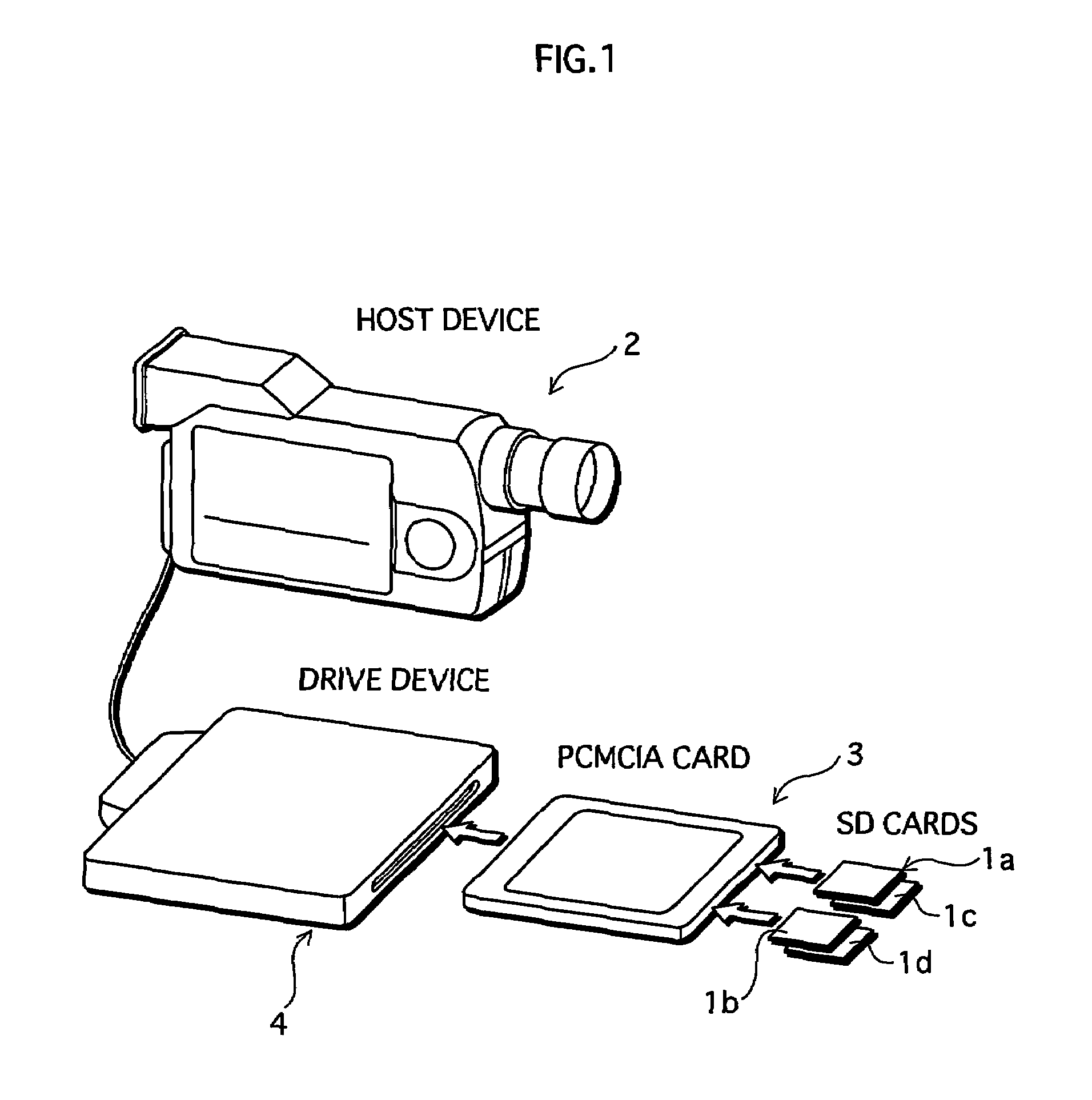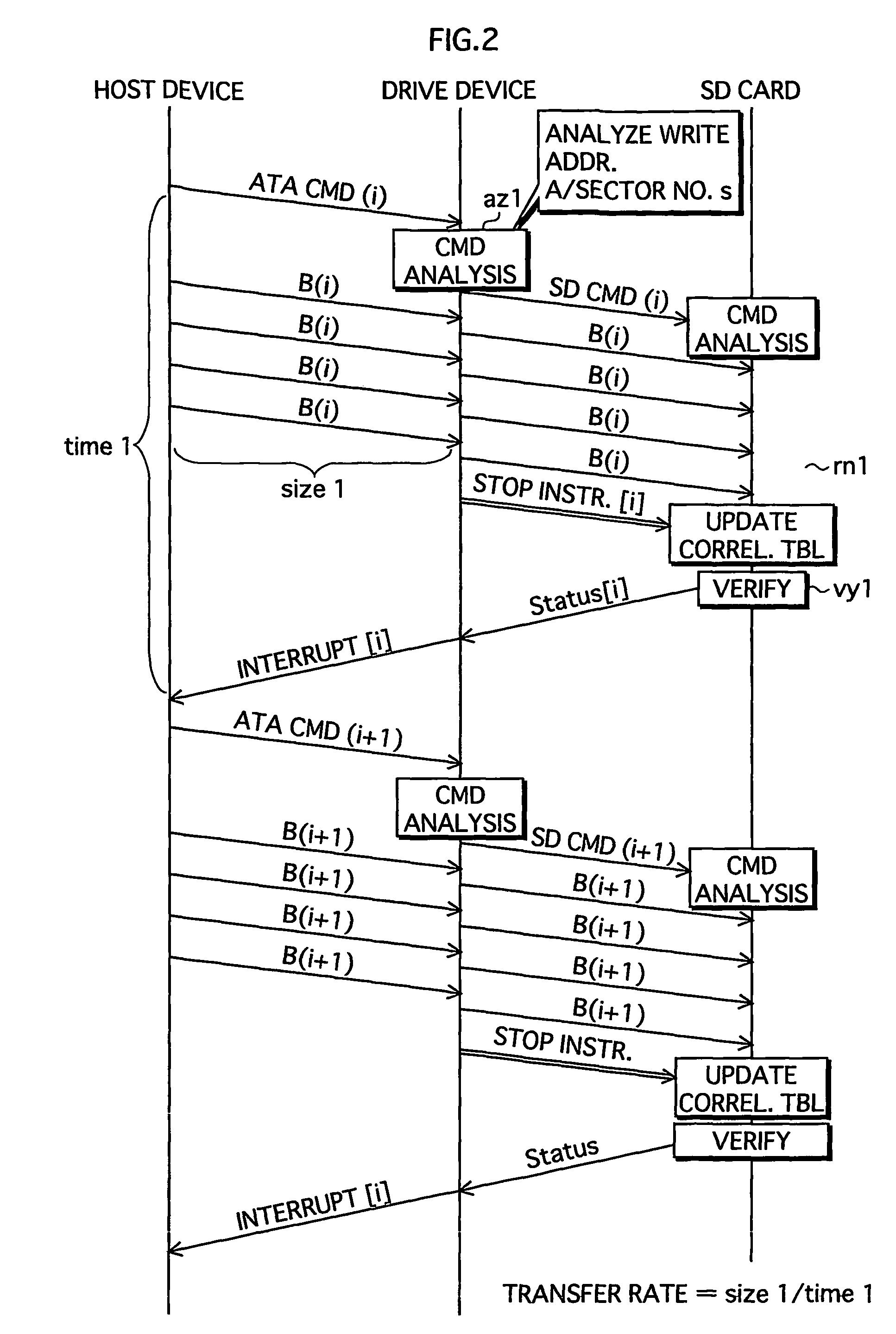Drive device and related computer program
a drive device and computer program technology, applied in computing, input/output to record carriers, instruments, etc., can solve the problem of overhead incurred when writing data to sd cards, and achieve the effect of not reducing the transfer ra
- Summary
- Abstract
- Description
- Claims
- Application Information
AI Technical Summary
Benefits of technology
Problems solved by technology
Method used
Image
Examples
embodiment 2
[0055]In embodiment 1, processing to be performed with a plurality of commands is executed in a single process if there is continuity between the write addresses. However, it is not necessarily the case that the longer the data size writable with a single process, the better. This is because SD card 1 has units called erasable blocks, and in the writing of data these erasable blocks must initially be returned to a blank state before data is written thereto. When the writing by a plurality of commands is performed in a single process, inefficient writing referred to here as “wraparound saving” arises if the sector number to be written is a non-integer multiple of an erasable block size.
[0056]FIGS. 9A to 9D show an example of wraparound saving. The erasable blocks in FIGS. 9A to 9D are here structured from p number of recording blocks. The given example assumes the rewriting of only data B of two pieces of data A and B written into one of the erasable blocks (upper block in FIG. 9A) i...
embodiment 3
[0060]With embodiment 1, it is possible, if the next command is transmitted before the transfer by the previous command has been completed, to combine the writing by these commands in a single process. However, if the next command is not received before the transfer by the current command has been completed, integration in the one process is no longer possible. Host device 2 pertaining to embodiment 3, which is designed to deal with such cases, transmits ATA commands with a wait flag appended thereto. If an ATA command with a wait flag is analyzed, command analysis unit 11 does not issue a STOP instruction, even when the scheduled number of sectors has been transferred to SD card 1. Because of this, the process is not concluded even though data transfer is not being performed. With no data for writing to SD card 1, command analysis unit 11 waits for the next command to be received from host device 2, and when received, unit 11 analyzes the command, and combines the writing by this c...
embodiment 4
[0063]With embodiment 2, command analysis unit 11 has card control unit 8 issue a STOP instruction to conclude the ongoing write process if a prohibit flag is attached to one of the ATA commands. However, it is not possible to conclude the process if the arrival of an ATA command with a prohibit flag is delayed, thus inviting a drop in transfer performance. As such, in embodiment 4, a prohibit flag is appended to the ATA command for performing the final writing of the process (i.e. ATA command whose data transfer results in the transferred data length being an integer multiple of the erasable block size). FIG. 12 shows an example of prohibit-flag appending as it pertains to embodiment 4. As shown in FIG. 12, a prohibit flag is appended to A[m], which is the ATA command for performing the final writing of the process. In FIG. 12, command analysis unit 11 has a STOP instruction issued at the point when the writing by ATA command [m] is finished. Data writing by the ongoing process can...
PUM
 Login to View More
Login to View More Abstract
Description
Claims
Application Information
 Login to View More
Login to View More - R&D
- Intellectual Property
- Life Sciences
- Materials
- Tech Scout
- Unparalleled Data Quality
- Higher Quality Content
- 60% Fewer Hallucinations
Browse by: Latest US Patents, China's latest patents, Technical Efficacy Thesaurus, Application Domain, Technology Topic, Popular Technical Reports.
© 2025 PatSnap. All rights reserved.Legal|Privacy policy|Modern Slavery Act Transparency Statement|Sitemap|About US| Contact US: help@patsnap.com



